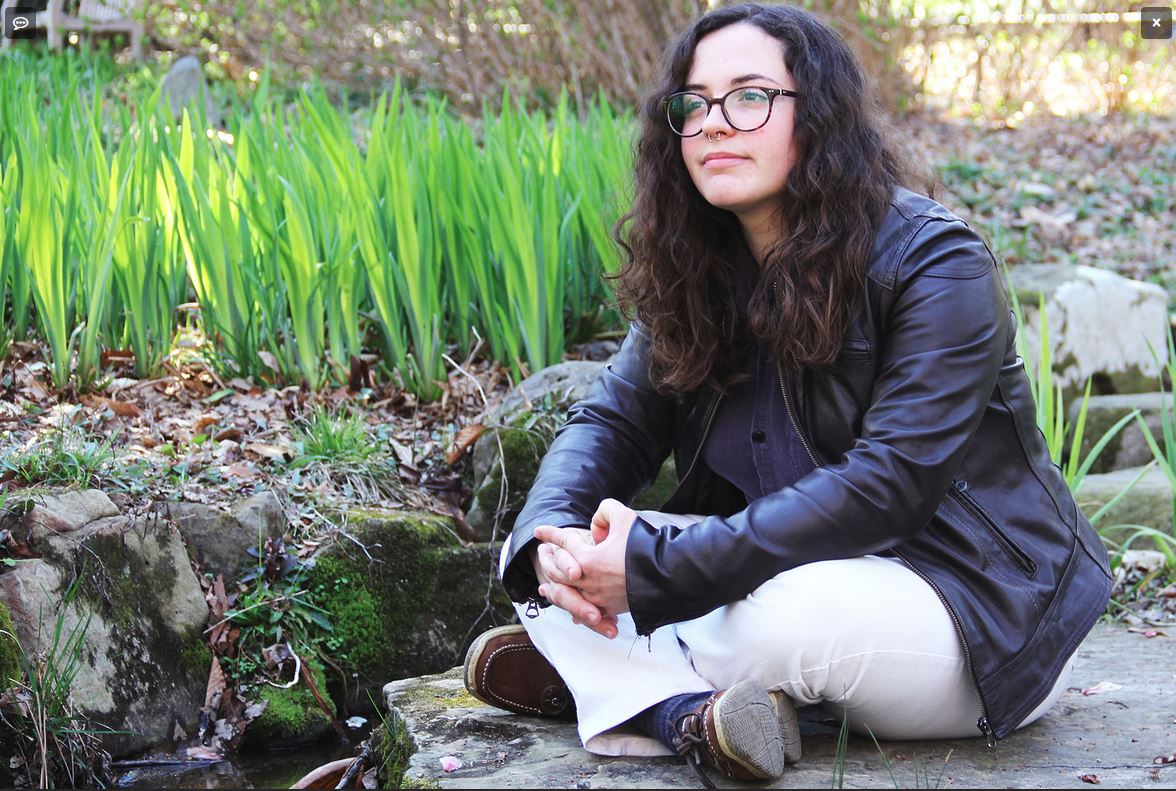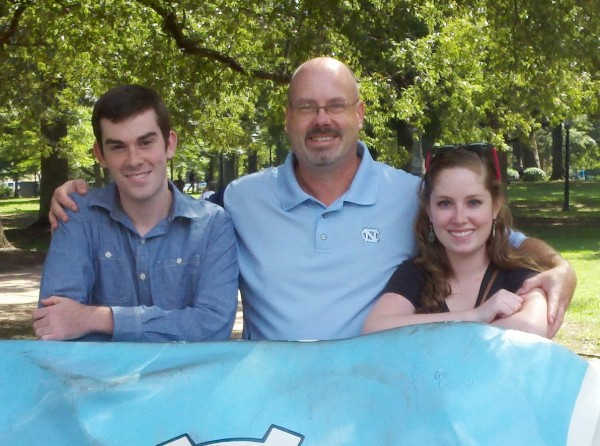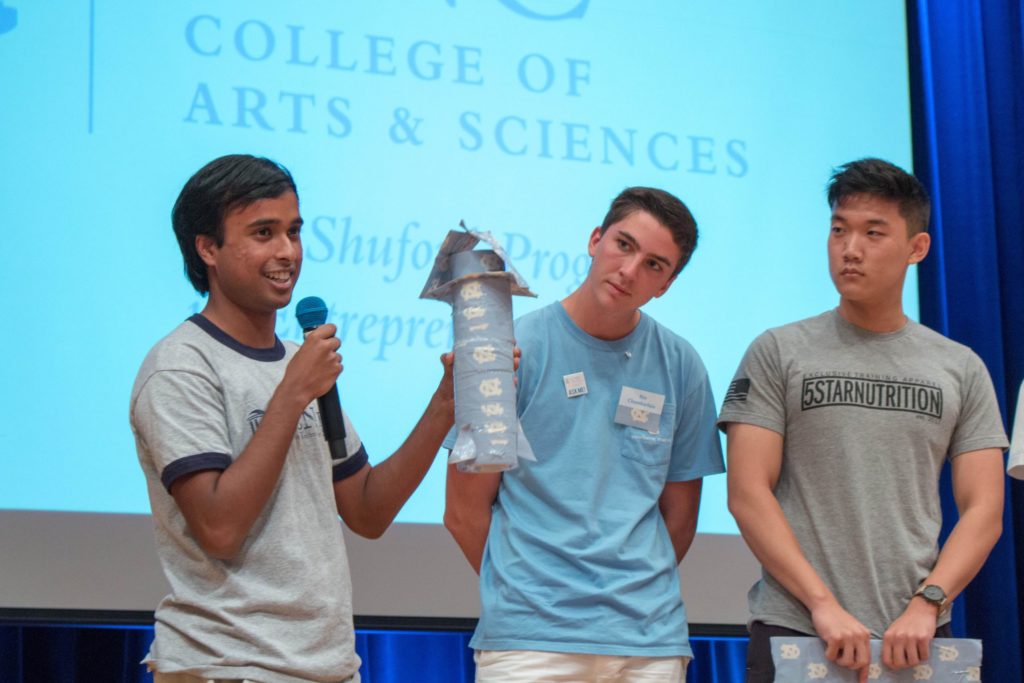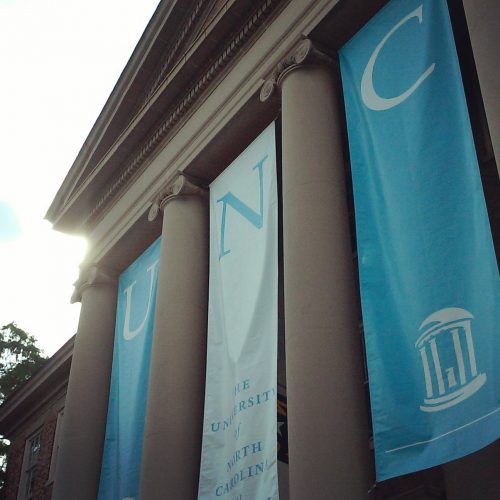
Even though more than 1.4 million American children under the age of 18 care for siblings or parents who have a chronic illness or disability, support for this demographic is in short supply. UNC geographer Elizabeth Olson in the College of Arts & Sciences and collaborators look to other countries as models for growing youth caregiver resources in the United States.
Bleep. Bleep. Bleep. LauraKathryn Smith’s eyes shoot open. She lets them adjust to the light before shutting off the alarm. After a few minutes, she slides out of bed and heads for the rooms of her older brother and sister to wake them. Once they’re up and moving, she gets dressed and heads to the kitchen, where she makes two bowls of cereal. She eats one and then brings the other into a nearby bedroom.
“We’re going to school now,” she tells her mom, who’s still in bed.
“Okay. Have a great day,” she says. Smith pauses for a minute — then sets the cereal on the bedside table, kisses her mom, and leaves.
Four years before Smith was born, her mother was diagnosed with multiple sclerosis (MS) — a disease of the central nervous system that disrupts the flow of information within the brain and between the brain and the body. MS symptoms vary for everyone and are often unpredictable.
“For most of her life she’s had relapsing-remitting MS, which is the most common form,” Smith says. But it still leads to symptom flare-ups like double-vision, dizziness, pain down the spine, and difficulty thinking clearly.
In response, Smith learned to be independent at an early age. She was 7 years old when she began waking her siblings for school — which they’d travel to by taking a golf cart to the local Kroger before hopping on a bus for 45 minutes. “We got used to making our own meals and doing our own laundry and taking ourselves to school,” she says.
When Smith was 11, her mother was hospitalized for two weeks. Smith and her brother ended up spending one month in foster care, and then six more with their grandparents. After that, Smith moved in with her dad, who also struggles with a disability; he has a traumatic brain injury.
“At some point it hit me,” Smith says. “Even though your parents are supposed to be the ones taking care of you — we think of them as superheroes who can do anything — that’s not always the case. And trying to come to grips with that as a kid and young adult is very difficult.”
—-
A youth caregiver is a young person under the age of 18 who provides care for a family member with a disability, chronic illness, or another health circumstance that requires care. There are more than 1.4 million youth caregivers in the United States alone, according to a 2005 prevalence study from the National Alliance for Caregiving.
But that statistic is severely outdated. That’s where Elizabeth Olson comes in. As a UNC childhood and youth geographer, she has spent the last decade researching the topic of youth caregivers.
In 2016, she began the Bookend Caregiving Project — a network of researchers and community members dedicated to improving the well-being of youth caregivers and the older adults with complex or chronic health conditions for whom they provide care. They work with schools, medical practitioners, and caregiver organizations to understand the priorities and unrecognized needs of these families.
At the same time, she’s building Carolina Student Carers, a network for students on campus who are caregivers for siblings, parents, grandparents, children, or even multiple family members. The student-caregiver combo presents daily challenges that can undermine success and progress toward a degree. Smith, a UNC senior studying psychology and women’s and gender studies, is helping Olson lead this group.
“It’s a very difficult decision to make,” Smith, who continues to care for her mother as a full-time student, adds. “Am I going to sacrifice my opportunities to put someone else’s needs before my own?”
“If you’re 17 years old and you are caregiving for your father who had a stroke, that may influence where you go to school or whether you need to just go out and get a job,” Olson says. “Caregiving can really shape a young person’s life trajectory. And we know that it can both limit and expand kids’ abilities.”
A wake-up call
Three pairs of eyes bore into Olson and her colleague Eduardo Serafín as they give a lesson on filmmaking to a youth group of 14- to 18-year-olds in Glasgow, Scotland, as part of a research project. The year is 2009.
While Serafín explains the process behind storyboarding scenes, Olson notices one participant lose her focus. Arms crossed, she stares off into the corner of the too-small room. Olson walks over to where she’s seated.
“Hey — are you okay? What’s going on?” Olson whispers.
“You guys don’t understand it,” the young woman says. “I was up for half the night last night because my mom was having a seizure and my sister was upset. And then I had to go to school and sit there and pretend like everything’s normal. Then I came here, and you are treating it just like it’s school again. I’m a young carer. I can’t have any more of this.”
Olson pauses for a moment — and then quickly shifts gears and rallies the group, leading them to a nearby shop and playground. She lets them mingle and take in the fresh air. They are still kids, after all.
“That girl was just 16 years old,” Olson remembers. “I was really quite naive, at that time, about what young people were doing as caregivers. Some of those I worked with in Scotland were losing a lot of sleep to help out a parent. Others spent countless hours in hospitals. From then on, I began doing a lot more listening. And I learned so much from them.”
Across the pond
For more than 20 years, the United Kingdom has recognized youth caregivers as a demographic. This means that any government organization there must ensure the protection of caregiver rights, with supports like better transportation, counseling services, and even the option to attend camp. Today, upon request, U.K. social workers will visit the homes of these kids to perform a “young carer needs assessment” to identify ways to assist the family.
The European Union is currently pushing for more collaboration and communication with youth caregivers in regards to legislation and research.
But the United States isn’t there yet.
After coming to UNC in 2011, Olson reached out to the Triangle J Area Agency on Aging. After spending three years working with youth caregivers overseas, she was surprised to learn that very few groups here knew about this population. In her continued search for fellow advocates, she eventually discovered the American Association of Caregiving Youth, led by Connie Siskowski — not only the organization’s founder and president but a former youth caregiver, as well.
Olson and Siskowski have since collaborated on multiple projects including the abovementioned Bookend Caregiving Project and the Caregiving Youth Research Collaborative, a network that seeks to support advances in research and practice for youth caregiving in the United States.
Now, the duo is in talks with other collaborators to undertake a national prevalence study, more than ten years after the first — and only — national study was conducted.
“It’s very difficult to fund, and it’s very difficult to conduct,” Olson points out. “But our current data is more than 10 years out of date and, during that time, we’ve had some dramatic changes in our population.” As the baby boomers age, for example, more and more children and young adults care for grandparents and older relatives — something called bookend caregiving. Olson believes this disproportionately affects low-income and immigrant families, in particular.
The Bookend Caregiving Strategic Advisory Board has also been developing a paper to communicate to the state and region what bookend caregiving is. What does it mean when we have families where young people are providing care for aging adults? The collaborative effort will create a tool that helps answer this question.
Someone to talk to
When Olson asks adults who cared for family members during their childhood what they wish people would have done differently when they were children, the answer is always the same: “I wish someone just would have asked me about it. I wish someone would have acknowledged what I did.”
That someone could have been a school guidance counselor, or a teacher, or a pediatrician. But American families don’t often divulge their youth caregivers because of misinterpretation, Olson points out. “The most common question I receive is this: What is the difference between youth caregiving and neglect? And then I have to explain that not all youth caregivers are neglected. In fact, for many, the act of caregiving is an important part of the family dynamic, especially across cultures.
“What’s really striking,” Olson continues, “is that, oftentimes, when you talk to young people who are caregivers, they will very quickly identify the person they care for as the center of their love. And they want to do this — to take care of this family member — in so many cases.”
Sometimes, though, the stress and disruption of caregiving becomes too much for a young person, especially if the family is already living with the pressures of poverty or social exclusion. But research and experience shows that this can be mitigated with the right kinds of support for youth caregivers and their families.
A helping hand
In Florida, Siskowski started the first comprehensive program in the nation to address the challenges faced by youth caregivers. The Caregiving Youth Project of Palm Beach provides resources like social workers to not only go into schools and represent these children, but to also host small gatherings where they can discuss shared issues and concerns.
“The project also identifies the needs of families,” Olson shares. “If a family is really struggling because they need a wheelchair ramp, then they will raise money for one. In the past, they’ve provided crockpots to make cooking easier, and even computers so students can complete their homework without having to be at school or in a library.”
Communication with the schools these kids attend is key. The project will notify them about common challenges youth caregivers might struggle with — things like tardiness, absenteeism, exhaustion, and bullying. “If the school knows why these things are happening, they can put some very minimal interventions into place to make sure that young person feels supported.”
Recent research shows that, when provided positive coping mechanisms, youth caregivers grow to become more compassionate human beings.
“If we can provide them with the opportunities to flourish and remove barriers to things like education, then we know they can develop tremendous empathy,” Olson says. “So they go into the world having grown from these experiences. They become people we can all learn from.”
Taking action
While youth caregivers receive little to no recognition across the nation, a broader, more familiar group called family caregivers does, largely because of their numbers — there are more than 40 million in the United States. For years, AARP has worked with more than 60 aging and disability organizations to rally support for this demographic.
In January, these groups applauded the passing of the Raise Family Caregivers Act, which, if made law, will create an advisory committee for articulating future family caregiving actions in the United States. Through the Department of Health and Human Services, it will develop, maintain, and update a national Family Caregiving Strategy — one that must include youth caregivers, Olson stresses.
“I hope that will finally get the message across that more and more young people are providing care,” she says. And with most baby boomers already in retirement, the United States literally does not have enough people — paid, volunteer, or family — to provide care.
To further that message, Olson continually speaks at events across the region. Just this month, she, Siskowski, and collaborators from local government agencies participated in a panel discussion at the North Carolina Association on Aging State Aging Conference. “The exciting thing is that, in just one year, we’ve transitioned from me as a researcher caring desperately about this situation to a whole network of people across the state who are stepping up,” she says.
That’s why Smith plans to, ultimately, become a social worker.
“I think I have a lot to add to the conversation because I have my own unique experience with my parents,” she says. “A lot of young caregivers don’t have anyone to talk to about this stuff, and it would have been so nice if I could have talked to anybody about what it’s like. So I’ve decided that I really want to work with nonprofits — with the people who struggle to get help.”
Story by Alyssa LaFaro, Endeavors magazine




